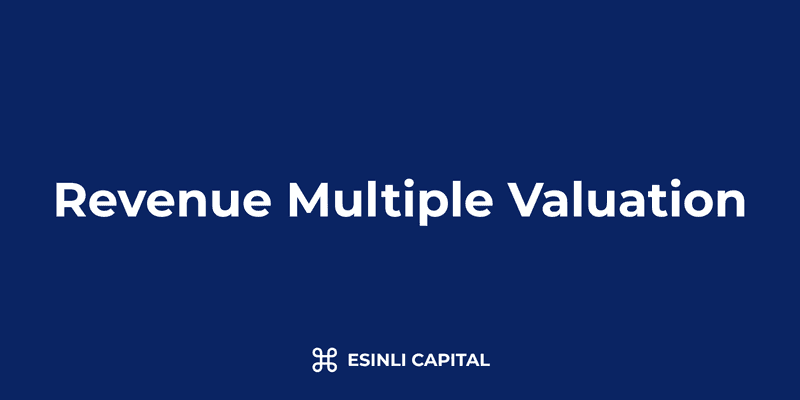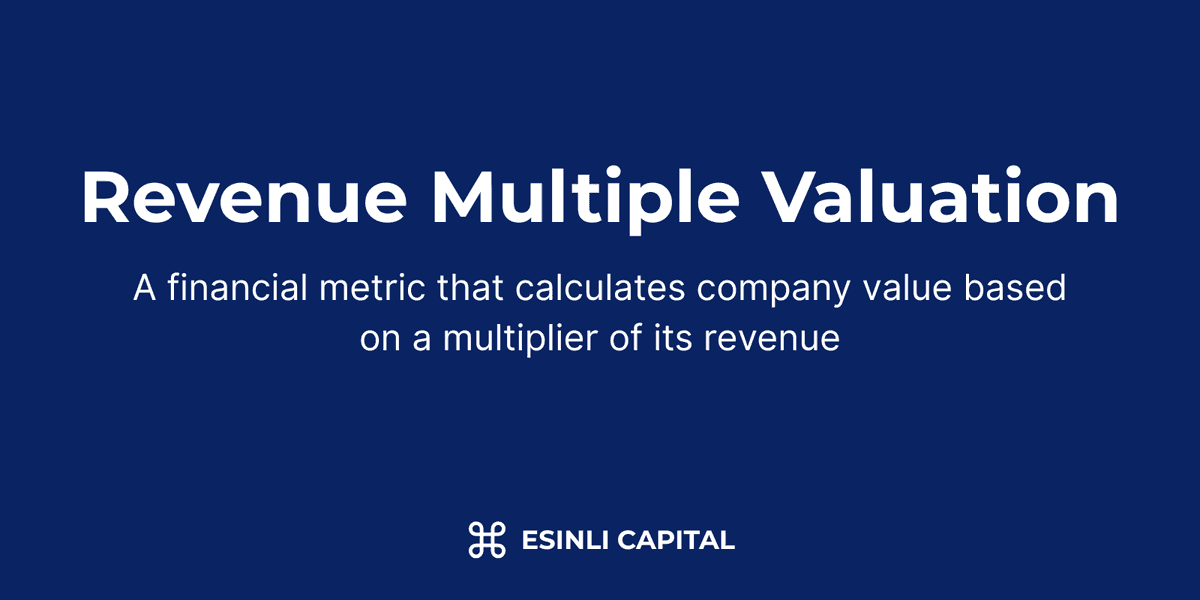In This Article
- What is Revenue Multiple Valuation?
- Why Revenue Multiples Matter More Than Ever
- How to Calculate Revenue Multiples
- Industry Benchmarks: What's a "Good" Revenue Multiple?
- Factors That Influence Revenue Multiples
- Revenue Multiple Valuation in Different Stages
- How to Apply Revenue Multiples to Your Company
- Common Pitfalls and How to Avoid Them
- Revenue Multiple Trends in 2025
- Enhancing Your Company's Revenue Multiple
- Revenue Multiple Valuation vs. Other Methods
- Revenue Multiple Valuation in Different Sectors
- The Bottom Line
- What is Revenue Multiple Valuation?
- Why Revenue Multiples Matter More Than Ever
- How to Calculate Revenue Multiples
- Industry Benchmarks: What's a "Good" Revenue Multiple?
- Factors That Influence Revenue Multiples
- Revenue Multiple Valuation in Different Stages
- How to Apply Revenue Multiples to Your Company
- Common Pitfalls and How to Avoid Them
- Revenue Multiple Trends in 2025
- Enhancing Your Company's Revenue Multiple
- Revenue Multiple Valuation vs. Other Methods
- Revenue Multiple Valuation in Different Sectors
- The Bottom Line

Revenue Multiple Valuation Method: Calculation, Industry Benchmarks & Application
KEY TAKEAWAYS
- Revenue multiple valuation determines a company's worth by multiplying its revenue by an industry-specific factor, typically ranging from 1x to 30x
- SaaS companies generally command higher multiples (5-15x) due to recurring revenue models, while traditional businesses often see lower multiples (1-3x)
- Growth rate significantly impacts multiples—companies growing 100%+ annually may receive double the multiple of those growing at 40%
- Revenue quality matters: recurring revenue, high gross margins, and customer retention metrics can substantially increase multiples
- Different stages require different approaches: pre-revenue startups rely on user metrics and traction, while later-stage companies use trailing twelve months (TTM) or annual recurring revenue (ARR)
What is Revenue Multiple Valuation?
Revenue multiple valuation is a financial methodology that determines a company's value by multiplying its annual revenue by a specific factor (the "multiple"). This approach is particularly prevalent in technology, SaaS, and high-growth industries where traditional valuation methods like discounted cash flow (DCF) may not accurately capture future potential.
The formula is straightforward:
Company Valuation = Revenue × Multiple
For example, if a SaaS company generates $5 million in annual recurring revenue (ARR) and the appropriate multiple for its industry and growth stage is 10x, its valuation would be $50 million.
This method gained prominence due to its simplicity and usefulness in situations where companies are not yet profitable but demonstrate strong revenue growth. Unlike earnings-based multiples (like P/E ratios), revenue multiples can provide meaningful valuations for pre-profit companies—making them essential in today's startup ecosystem.
Why Revenue Multiples Matter More Than Ever
For Investors
Revenue multiples serve as a critical benchmarking tool for investors. They provide:
- Comparative Analysis: Quick comparisons between similar companies in a sector
- Investment Screening: Efficient way to identify potentially undervalued opportunities
- Standardized Metrics: Common language for venture capital, private equity, and M&A discussions
When evaluating investment opportunities, VCs and angel investors frequently begin with revenue multiples before diving deeper into other metrics. A company trading at a lower multiple than its peers might signal an undervalued investment—or it might indicate underlying problems not immediately evident in revenue figures.
For Founders
For entrepreneurs, understanding revenue multiples delivers several advantages:
- Realistic Valuation Expectations: Setting appropriate fundraising targets
- Strategic Decision Making: Understanding which growth metrics most impact valuation
- Exit Planning: Building toward specific valuation milestones
- Competitive Positioning: Knowing how your metrics compare to competitors
Founders who understand industry multiples gain leverage in negotiations and can make better-informed strategic decisions about growth priorities.
How to Calculate Revenue Multiples
Basic Calculation
The fundamental calculation involves dividing enterprise value (EV) by annual revenue:
Revenue Multiple = Enterprise Value ÷ Annual Revenue
Where:
- Enterprise Value = Market Cap + Total Debt - Cash and Cash Equivalents
- Annual Revenue is typically trailing twelve months (TTM) revenue
Which Revenue Figure Should You Use?
Different contexts may call for different revenue metrics:
- Trailing Twelve Months (TTM): Most common for established businesses
- Annual Recurring Revenue (ARR): Standard for SaaS companies
- Forward Revenue: Based on projections, often used for high-growth companies
- Run Rate: Current month's revenue multiplied by 12 (useful for rapidly scaling companies)
For SaaS businesses, ARR typically provides the most meaningful valuation benchmark, while e-commerce companies might focus on TTM revenue with seasonal adjustments.
Sample Calculation
Consider a fintech startup with:
- $10 million in TTM revenue
- $2 million in debt
- $1 million in cash
- 100,000 outstanding shares trading at $2.30 per share
Enterprise Value = ($2.30 × 100,000) + $2 million - $1 million = $230,000 + $2 million - $1 million = $1.23 million
Revenue Multiple = $1.23 million ÷ $10 million = 0.123x
This extremely low multiple would suggest the company is significantly undervalued compared to typical fintech multiples (often 5-15x), warranting deeper investigation.
Industry Benchmarks: What's a "Good" Revenue Multiple?
Revenue multiples vary dramatically across industries. Here's a breakdown of typical ranges as of 2025:
SaaS and Software
- Enterprise SaaS: 8-15x ARR
- SMB-focused SaaS: 5-10x ARR
- Developer Tools: 15-25x ARR
- Security Software: 7-12x ARR
Technology
- Marketplace Platforms: 5-10x revenue
- E-commerce: 1-3x revenue
- Hardware: 1-4x revenue
- Fintech: 5-15x revenue
Traditional Industries
- Retail: 0.5-1.5x revenue
- Manufacturing: 0.8-2x revenue
- Service Businesses: 1-3x revenue
- Consumer Packaged Goods: 2-4x revenue
These benchmarks fluctuate with market conditions, economic cycles, and sector-specific disruptions. During the 2021 tech boom, SaaS multiples reached as high as 30-40x ARR for the fastest-growing companies, before normalizing to lower levels in subsequent years.
Factors That Influence Revenue Multiples
Multiple key factors determine whether a company receives a premium or discount to industry average multiples:
Growth Rate
Perhaps the most influential factor, growth rate demonstrates future potential:
| Annual Growth Rate | Multiple Premium |
|---|---|
| 10-20% | Base multiple |
| 20-40% | +25% to multiple |
| 40-60% | +50% to multiple |
| 60-100% | +75% to multiple |
| 100%+ | +100% or more to multiple |
A SaaS company growing at 100%+ annually might receive a 15x multiple, while a similar company growing at 30% might only command 7-8x.
Revenue Quality
Not all revenue is valued equally:
- Recurring Revenue: Subscription models command higher multiples than one-time sales
- Gross Margins: 80%+ gross margins often lead to premium multiples
- Customer Concentration: Revenue spread across many customers is more valuable than reliance on a few large clients
- Churn Rate: Low customer churn signals sustainable growth
- Expansion Revenue: Companies with strong net revenue retention (120%+) receive premium multiples
Market Position
- Market Size: TAM (Total Addressable Market) significantly impacts multiples
- Market Share: Category leaders command premium valuations
- Competitive Landscape: Less competition typically means higher multiples
- Barriers to Entry: Strong technological moats or network effects increase multiples
Operating Metrics
- Customer Acquisition Cost (CAC): Efficient customer acquisition correlates with higher multiples
- CAC Payback Period: Faster payback periods justify higher valuations
- Rule of 40: Companies whose growth rate plus profit margin exceeds 40% often receive premium multiples
Revenue Multiple Valuation in Different Stages
Pre-Revenue Startups
For pre-revenue companies, pure revenue multiples aren't applicable. Instead, valuations typically consider:
- User metrics (MAU/DAU)
- Growth trajectory
- Comparable company acquisitions
- Team experience and track record
- Technological innovation or IP
Once minimal revenue begins, investors might apply aggressive multiples to current run rates or projected first-year revenue, particularly if traction metrics are strong.
Early-Stage Companies
Companies with 1-3 years of revenue history typically see valuations based on:
- Current ARR with emphasis on growth rate
- Revenue run rate for rapidly scaling businesses
- Customer acquisition metrics
- Market opportunity size
At this stage, multiples often reflect potential rather than current financial performance, with considerable weight placed on growth trajectory.
Growth-Stage Companies
Companies with established revenue streams focus on:
- TTM revenue or current ARR
- Year-over-year growth rates
- Improving unit economics
- Path to profitability
- Strategic value in the market
Public Companies and Late-Stage Private Companies
Mature companies typically use:
- TTM revenue with forward projections
- Profitability metrics alongside revenue
- Comparable public company benchmarks
- Rule of 40 and other efficiency metrics
How to Apply Revenue Multiples to Your Company
Step-by-Step Process
-
Identify comparable companies: Select 5-10 companies similar to yours in:
- Business model
- Target market
- Growth stage
- Revenue scale
-
Gather revenue multiple data for each comparable:
- For public companies: Use financial databases like Capital IQ, Bloomberg, or Yahoo Finance
- For private companies: Research recent fundraising announcements, industry reports, and acquisition data
-
Adjust for company-specific factors:
- Apply premiums or discounts based on your growth rate relative to comparables
- Adjust for revenue quality differences
- Consider market position variations
-
Calculate a range rather than a single value:
- Determine the 25th percentile, median, and 75th percentile multiples
- Apply these to your revenue to establish a valuation range
-
Validate with alternative methods:
- Compare with DCF valuation
- Test against recent transaction multiples
- Consider feedback from industry experts
Practical Example
Imagine you run a B2B SaaS company with:
- $3M ARR growing at 70% annually
- 85% gross margins
- 110% net revenue retention
- Enterprise customers with 1% churn rate
After analyzing comparable companies, you find:
- Median multiple for your sector: 8x ARR
- Growth premium for 70% growth: +75% to multiple
- Premium for strong retention metrics: +15% to multiple
Adjusted multiple: 8x × (1 + 0.75 + 0.15) = 15.2x Valuation range: $3M × 15.2x = $45.6M
Common Pitfalls and How to Avoid Them
Overreliance on Revenue Multiples
While convenient, revenue multiples shouldn't be the only valuation method. Complement with:
- DCF analysis for long-term projections
- Precedent transactions for market reality checks
- Strategic value assessments
Cherry-Picking Comparables
Selecting only the highest-multiple companies as comparables creates unrealistic expectations. Instead:
- Choose a representative sample of the market
- Include both aspirational and conservative comparables
- Calculate median values rather than averages to avoid outlier distortion
Ignoring Revenue Quality
Not all revenue deserves the same multiple. Consider:
- Customer concentration risk
- Contract length and renewability
- Seasonality and predictability
- Services revenue vs. product revenue
Failing to Adjust for Growth Stage
A $1M ARR company growing 100% annually deserves a different multiple than a $50M ARR company growing at the same rate. Account for:
- Scale-specific challenges
- Market penetration percentages
- Corresponding efficiency metrics at each stage
Revenue Multiple Trends in 2025
SaaS Multiple Contractions
After the 2021 peaks, SaaS multiples have generally normalized. As of 2025:
- High-growth public SaaS companies average 10-15x revenue
- Median SaaS multiples remain approximately 6-8x
- Efficiency and path to profitability have gained importance over pure growth
Sector-Specific Shifts
Different sectors have seen varying multiple trends:
- AI and Machine Learning: Sustained premium multiples (15-25x)
- Cybersecurity: Resilient multiples due to persistent demand (8-12x)
- Vertical SaaS: Increasingly valued for industry specialization (7-10x)
- Consumer Tech: More scrutiny and lower multiples than B2B counterparts (4-8x)
Public-Private Valuation Gap
The gap between public and private company valuations has narrowed, with:
- Late-stage private rounds more closely matching public market benchmarks
- Greater emphasis on proven unit economics before IPO
- More conservative growth projections in valuation models
Enhancing Your Company's Revenue Multiple
Focus on High-Quality Revenue
To maximize your multiple:
- Shift to subscription models where possible
- Improve gross margins through operational efficiency
- Reduce customer concentration risk
- Extend contract lengths and improve renewal rates
- Implement price increases successfully
Accelerate Growth Sustainably
Since growth rate significantly impacts multiples:
- Optimize sales efficiency to grow faster with the same investment
- Expand into adjacent markets strategically
- Develop new revenue streams that leverage existing customers
- Improve product-led growth mechanisms
Demonstrate Market Leadership
Category leaders command premium multiples:
- Establish thought leadership through content and speaking
- Obtain analyst recognition from firms like Gartner or Forrester
- Track and publicize market share gains
- Create proprietary market data that positions you as an authority
Improve Unit Economics
Efficiency metrics increasingly matter:
- Reduce CAC through marketing optimization
- Shorten sales cycles with better qualification
- Improve net revenue retention through upselling and cross-selling
- Extend customer lifetime value through added services
Revenue Multiple Valuation vs. Other Methods
Comparison with DCF Valuation
| Aspect | Revenue Multiple | DCF |
|---|---|---|
| Time Horizon | Current/Near-Term | Long-Term (5-10 years) |
| Complexity | Simple | Complex |
| Assumptions | Few | Many |
| Best For | High-Growth, Pre-Profit | Established, Profitable |
| Market Influence | High | Low |
Comparison with Earnings Multiples
| Aspect | Revenue Multiple | Earnings Multiple (P/E) |
|---|---|---|
| Applicability | Pre-Profit Companies | Profitable Companies |
| Growth Focus | High | Moderate |
| Accounting Sensitivity | Low | High |
| Capital Structure Impact | Low | High |
When to Use Each Method
- Revenue Multiples: Best for high-growth companies, especially in technology and SaaS
- DCF Valuation: Ideal for mature businesses with predictable cash flows
- Earnings Multiples: Suitable for profitable companies with established earnings history
- Asset-Based Valuation: Appropriate for capital-intensive businesses or distressed scenarios
A comprehensive valuation typically incorporates multiple methodologies, with different weights assigned based on the company's specific circumstances.
Revenue Multiple Valuation in Different Sectors
SaaS and Software
SaaS companies typically receive the highest revenue multiples due to:
- Recurring revenue models
- High gross margins (70-90%)
- Scalability with limited incremental costs
- Strong customer retention metrics
Leading indicators include ARR growth rate, net revenue retention, and CAC payback period.
E-commerce
E-commerce multiples typically range lower:
- Non-recurring revenue models
- Lower gross margins (20-40%)
- Higher customer acquisition costs
- Inventory management challenges
Key metrics include gross merchandise value (GMV), customer lifetime value (LTV), and repeat purchase rates.
Marketplaces
Marketplace businesses sit between SaaS and e-commerce:
- Transaction-based revenue
- Asset-light models
- Network effects creating defensibility
- Variable take rates
Critical metrics include gross transaction value (GTV), take rate trends, and marketplace liquidity.
Hardware and Physical Products
These businesses typically receive the lowest multiples:
- Capital-intensive operations
- Lower gross margins
- Supply chain dependencies
- Cyclical demand patterns
Manufacturers focus on revenue predictability, order backlog, and operational efficiency to maximize multiples.
The Bottom Line
Revenue multiple valuation provides a straightforward, market-based approach to company valuation, particularly useful for high-growth businesses without substantial profits. While seemingly simple, skillful application requires nuanced understanding of industry benchmarks, growth implications, and revenue quality factors.
The most effective valuations blend multiple approaches, using revenue multiples as one important piece of a comprehensive analysis. For founders and investors alike, understanding the mechanics of revenue multiples—and the factors that influence them—provides crucial insights for fundraising, strategic planning, and exit strategies.
As markets evolve, so too will the multiples assigned to different sectors. Staying informed about industry benchmarks and valuation trends remains essential for anyone involved in startup financing, M&A activities, or investment decisions.



